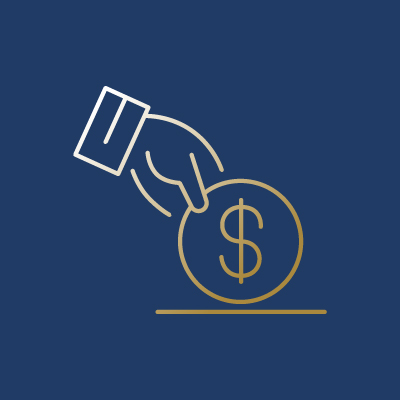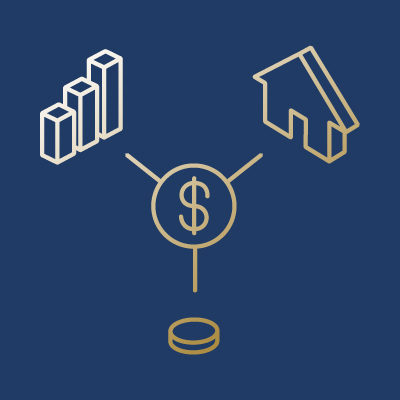
You don’t need to commit a large amount of money all at once to start investing. Regular investing is an effective way to build up your portfolio. While small contributions may not seem like much at first glance, regular investing can add up over the course of a lifetime with the effect of compounding.
If you have a savings account like Standard Chartered XtraSaver, you will automatically benefit from compound interest. However, if you are investing, you can also use compounding by consistently re-investing any interest or dividends you receive back from your investment. For example, if you own shares that give you dividends, you can use those dividends to buy more shares which will give you even more dividends. This way, you are continuously putting a larger amount of money to work, and your investment return will be compounded over time.

One of the most difficult investment decisions is ‘when to buy.’ This can be one of the most frustrating parts of investing. One of the benefits of investing with our Regular Savings Plan is the effect of ‘Dollar cost averaging’ which takes the worry and emotion out of when to buy or sell.

Dollar cost averaging is simply the effect of investing a fixed amount of money into a particular investment at regular intervals usually monthly or quarterly. For example, investing AED 1,000 at the end of each month into a company’s shares or a mutual fund.
Share prices rise and fall. So one month your AED 1,000 will buy you a certain amount of shares, and the next month, if the share price has risen, your AED 1,000 will only buy less shares. The next month, if the share price has dropped, your AED 1,000 will buy more shares again. Thus you automatically buy more shares when prices are lower, and less shares when they are higher. This is the cost-averaging effect.

Regular investing takes the worry out of market timing (watching the stock market closely trying to buy and sell at the right time or being emotionally affected by the markets going up or down) as there is no need to predict when to get in or out of an investment. It also reduces the risk of investing a large amount in a single investment at the wrong time.

When the market is going down, you may feel very tempted to sell — that’s why despite the adage “buy low, sell high”, many investors end up doing the opposite — or not put in their regular investment. However, that would nullify the strategy’s basic idea of buying more of an investment when the market falls.
Conversely, you may feel exuberant and want to invest more in a rising market. But you may end up paying a higher average price or buying at the top of the market, which is what this strategy is designed to avoid.

Having said that, dollar cost averaging (regular investing) into a bad specific investment doesn’t make sense. However, if you keep regularly investing in a mutual fund or index fund the impact of market fluctuations is reduced as the investment risk is diversified i.e. spread over a variety of investment categories (asset classes) from various regions.

Everyone knows the saying: don’t put all your eggs into one basket. That is diversification in a nutshell. When you diversify, you hold a wider range of investments. There is always a risk that any single one of them can suddenly have a significant loss of value. But by diversifying, it won’t affect your total investment value as much. You are spreading this risk around.
A well-diversified investment portfolio consists of groups of assets which are lowly or negatively correlated with each other. This means they are in unrelated industries or sectors or even countries. When one might take a dip, the other might rise.
Example
An investor holding a portfolio of 30 different technology stocks doesn’t have much diversity. All their portfolio is in technology and in stocks.
An investor with a portfolio covering a range of industries, bonds, mutual funds and real estate, has a good level of diversification. If real estate takes a dip, for example, the other investments may not be affected.
You can diversify your portfolio within one asset class, e.g. own only stocks, but in a wide range of industries. Thus, the risk of each individual stock dropping is largely mitigated.
You can also diversify among different asset classes – like holding a mix of stocks, bonds and real estate. This is a more diversified portfolio, especially across a broad range of industries.
At Standard Chartered, we offer a mix of investment products to diversify your portfolio, including: equities, mutual funds, fixed income solutions, foreign exchange and precious metals, as well as structured products – with exposure to currency, interest rates, bonds, commodities, funds and equity markets, depending on your investment profile.
To summarize, there is no such thing as one perfect investment strategy as it depends on your goals, your personal appetite for risk and your need for accessible funds. Our Wealth Specialists are here to help you develop a smart, personal investment plan. Backed by a global team of more than 150 economists, they analyse the global financial outlook to find insights that can give your investments the edge.
This article is brought to you by Standard Chartered Bank UAE. All information provided is for informational purposes only.
Disclaimer:
This article is for general information only and it does not constitute an offer, recommendation or solicitation to enter into any transaction. This article has not been prepared for any particular person or class of persons and it has been prepared without regard to the specific investment or insurance objectives, financial situation or particular needs of any person. You should seek advice from a licensed or an exempt financial adviser on the suitability of a product for you, taking into account these factors before making a commitment to purchase any product. In the event that you choose not to seek advice from a licensed or an exempt financial adviser, you should carefully consider whether the product is suitable for you. You are fully responsible for your investment decision, including whether the investment is suitable for you. The products/services involved are not principal-protected and you may lose all or part of your original investment amount.







